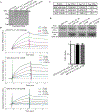Heterozygous variants in MYBPC1 are associated with an expanded neuromuscular phenotype beyond arthrogryposis
- PMID: 31264822
- PMCID: PMC6688907
- DOI: 10.1002/humu.23760
Heterozygous variants in MYBPC1 are associated with an expanded neuromuscular phenotype beyond arthrogryposis
Abstract
Encoding the slow skeletal muscle isoform of myosin binding protein-C, MYBPC1 is associated with autosomal dominant and recessive forms of arthrogryposis. The authors describe a novel association for MYBPC1 in four patients from three independent families with skeletal muscle weakness, myogenic tremors, and hypotonia with gradual clinical improvement. The patients carried one of two de novo heterozygous variants in MYBPC1, with the p.Leu263Arg variant seen in three individuals and the p.Leu259Pro variant in one individual. Both variants are absent from controls, well conserved across vertebrate species, predicted to be damaging, and located in the M-motif. Protein modeling studies suggested that the p.Leu263Arg variant affects the stability of the M-motif, whereas the p.Leu259Pro variant alters its structure. In vitro biochemical and kinetic studies demonstrated that the p.Leu263Arg variant results in decreased binding of the M-motif to myosin, which likely impairs the formation of actomyosin cross-bridges during muscle contraction. Collectively, our data substantiate that damaging variants in MYBPC1 are associated with a new form of an early-onset myopathy with tremor, which is a defining and consistent characteristic in all affected individuals, with no contractures. Recognition of this expanded myopathic phenotype can enable identification of individuals with MYBPC1 variants without arthrogryposis.
Keywords: MYBPC1; arthrogryposis; hypotonia; myopathy; myosin binding protein-C; tremor.
© 2019 Wiley Periodicals, Inc.
Conflict of interest statement
CONFLICT OF INTEREST STATEMENT
None of the authors has a conflict of interest.
Figures



References
-
- Atlas, H. P. (version 17). https://www.proteinatlas.org/.
Publication types
MeSH terms
Substances
Grants and funding
LinkOut - more resources
Full Text Sources
Medical
Molecular Biology Databases

